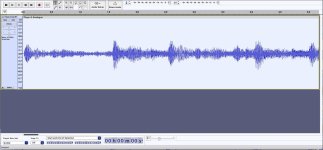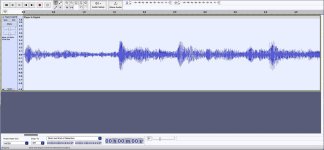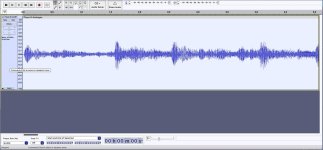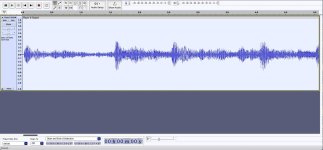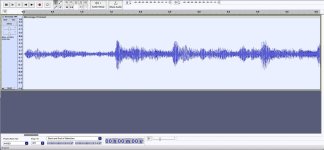After I finished listening to the tracks, multiple times, out of curiosity I decided to watch the display of the spectrum analyzer as I replayed each track one more time. When I got to the Micromega track I noticed the first note did not register on the display. From this observation, I jumped to the conclusion that the track was at a slightly lower volume level.
To try to pin this observation down, I looked closely at the first few seconds of each track with Audacity. Since the spectrum analyzer was set display combined left and right channels, I summed left and right to a mono signal, and then selected the first 5 seconds and zoomed to that selection. The results are shown in the attachments. If you look at just that first note for each track, the Micromega looks to have a lower amplitude. I am not sure this lower amplitude extends for the entire track, but it seems possible. I am assuming it is just a fraction of a dB but I have not tried to quantify it. Does seem interesting.
Cheers
To try to pin this observation down, I looked closely at the first few seconds of each track with Audacity. Since the spectrum analyzer was set display combined left and right channels, I summed left and right to a mono signal, and then selected the first 5 seconds and zoomed to that selection. The results are shown in the attachments. If you look at just that first note for each track, the Micromega looks to have a lower amplitude. I am not sure this lower amplitude extends for the entire track, but it seems possible. I am assuming it is just a fraction of a dB but I have not tried to quantify it. Does seem interesting.
Cheers
Attachments
Well time is just about up and so firstly may I say many thanks to all those that took the time to give these a listen.

To put you all out of your misery I can reveal that Recorder A was the budget MDS-JE480 and Recorder B was the older MDS-JB920. Both are very good in what they do imo and differences are very hard to pick out I have found.
The poll has only a small number of samples unfortunately and as such I'm not sure statistically if it reveals very much.
Thanks again for listening
To put you all out of your misery I can reveal that Recorder A was the budget MDS-JE480 and Recorder B was the older MDS-JB920. Both are very good in what they do imo and differences are very hard to pick out I have found.
The poll has only a small number of samples unfortunately and as such I'm not sure statistically if it reveals very much.
Thanks again for listening
I'm the one who preferred the digital output of MDS-JB920. I felt that both players in digital and analog mode processed the "original" Micromega signal. MDS-JE480 analog output sounds like running out of headroom especially in singer's voice bursts. Its digital output is better however, MDS-JB920 sounds better in both modes, with digital output being closer to my preference.
Thanks for sharing your thoughts  the older recorder would definitely be considered the more 'audiophile' of the two and particularly in terms of component quality and sophistication while the MDS JE480 is far more ordinary although sporting the latest technology.
the older recorder would definitely be considered the more 'audiophile' of the two and particularly in terms of component quality and sophistication while the MDS JE480 is far more ordinary although sporting the latest technology.
I think I better just clarify the actual setup used for creating these files and I'm sorry if this wasn't clear, not that it alters anything at all with the impressions... those remain as they are.
The 'Digital' files were recorded using the recorders TOSLINK inputs fed directly from the Micromega while the 'Analogue' files used the standard RCA audio output of the Micromega and fed into the analogue line inputs of the recorders. So in record mode we have 'Digital' recordings made via TOSLINK and recordings that have been through the recorders own A/D conversion using the standard RCA audio feeds.
The analogue outputs of the recorders and the Micromega (for the reference) were used to create all the files by feeding into a DAC with the result being processed in Audacity.
I think I better just clarify the actual setup used for creating these files and I'm sorry if this wasn't clear, not that it alters anything at all with the impressions... those remain as they are.
The 'Digital' files were recorded using the recorders TOSLINK inputs fed directly from the Micromega while the 'Analogue' files used the standard RCA audio output of the Micromega and fed into the analogue line inputs of the recorders. So in record mode we have 'Digital' recordings made via TOSLINK and recordings that have been through the recorders own A/D conversion using the standard RCA audio feeds.
The analogue outputs of the recorders and the Micromega (for the reference) were used to create all the files by feeding into a DAC with the result being processed in Audacity.
I compared the reference with both analogue A and digital A.
First track: ref.
Second track: analogue A
Third track: digital A
Both channels scanned hence the dual frequency plot.
The 3 colours above the Frequency Analyses window, green, red, blue, one for each track, overlap nicely.

Here is the ref. compared to Analogue B and Digital B.
First track: ref.
Second track: analogue B
Third track: digital B

Hugo
First track: ref.
Second track: analogue A
Third track: digital A
Both channels scanned hence the dual frequency plot.
The 3 colours above the Frequency Analyses window, green, red, blue, one for each track, overlap nicely.
Here is the ref. compared to Analogue B and Digital B.
First track: ref.
Second track: analogue B
Third track: digital B
Hugo
For anyone interested 
All the talk of LP modes had me try something out, a single track (totally different musical genre this time around with lots of HF content) that changes seamlessly through the different modes. It starts out in LP2 mode until 45 seconds in at which point it changes to 'Normal'. That carries through until 1min 30 secs at which point it switches to LP4 until the end. That is the changeover that is most noticeable. LP4 mode is giving over 5 hours 20 minutes recording.
All the talk of LP modes had me try something out, a single track (totally different musical genre this time around with lots of HF content) that changes seamlessly through the different modes. It starts out in LP2 mode until 45 seconds in at which point it changes to 'Normal'. That carries through until 1min 30 secs at which point it switches to LP4 until the end. That is the changeover that is most noticeable. LP4 mode is giving over 5 hours 20 minutes recording.
Attachments
I had a listen and a look at the track.
I can't hear the difference between LP2 and normal mode, but LP4 is definitely audible when compared.
Looking at the spectrum, one can see how much information is lost in LP4 mode. I would compare it to 128k MP3.
The magnified part clearly shows the 'holes'.
Also, the spectral phase display shows a very different pattern and the loss of info.
The redish line in the center is weird.
If these modes are used as intended, they are nevertheless very useful.



I can't hear the difference between LP2 and normal mode, but LP4 is definitely audible when compared.
Looking at the spectrum, one can see how much information is lost in LP4 mode. I would compare it to 128k MP3.
The magnified part clearly shows the 'holes'.
Also, the spectral phase display shows a very different pattern and the loss of info.
The redish line in the center is weird.
If these modes are used as intended, they are nevertheless very useful.
That first shot is quite graphic, if I'm interpreting it correctly there seems to be a hard limit on bandwidth in LP4 mode with nothing over 14k present. When listening one of the biggest changes I notice is the stereo image reduces considerably in LP4 mode. A real narrowing of the sound stage.

I recorded the track three times, once in each mode and then cut and spliced them using Audacity. Thanks for listening
On the contrary, both transitions are seamless to me. I can't tell about micro details but it doesn't sound less vivid or like typical harsh mp3.
I recorded the track three times, once in each mode and then cut and spliced them using Audacity. Thanks for listening
- Home
- Source & Line
- Digital Source
- Listening Comparison. Two Minidisc Recorders. One a Late Budget Model, the Other Older but more Audiophile Oriented
